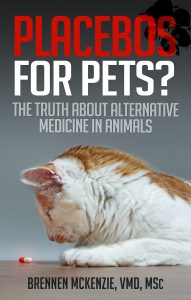The terminology associated with unconventional therapies has shifted a bit over the last 40 or so years. Initially, such therapies were often described as “alternative.” This fit well with the still widespread philosophical position that new or different ways of looking at health and disease which are not part of the scientific tradition are necessary or valuable. But it wasn’t the most effective marketing for these practices since it suggests substituting these therapies for conventional medicine. The dramatic effectiveness of science-based medicine is hard to ignore, and most people aren’t willing to give it up for the promises of unproven alternatives.
The term “complementary and alternative medicine” (CAM) emerged to suggest a more flexible approach in which unconventional therapies could add benefits along with, not only in place of, conventional medicine. This is still a popular term, but some advocates of CAM therapies dislike the implication it carries that science-based medicine is the mainstay of treatment and CAM simply “complements” it. And it can be quite clumsy to say.
So the latest term that seems to be gaining ground quickly is “integrative medicine.” This suggests a seamless merging of the best of conventional and unconventional medicine. Integrative medicine advocates often present this approach as focused only on the welfare of the patient and willing to use whatever tools are appropriate without any prejudice regarding their origins. What could be wrong with that?
Well, to begin with, there is a hidden and untrue assumption behind this approach; that individual practices from both CAM and scientific medicine are equivalent, equally likely to be useful regardless of the philosophies behind them. The problem with this assumption is that there is, in fact, good reason to believe that therapies based in science and validated by scientific research are far more likely to be safe and effective than therapies based on implausible or pseudoscientific theories and validated by historical use, individual anecdotes, and little to no controlled scientific research.
Among some skeptics, integrative medicine programs in academic medical centers have been labeled quackademic medicine. This is the integration of implausible and unproven alternative therapies into academic medical practice not, as is often claimed, with the intent of investigating whether or not such therapies are safe and effective but with a pre-existing faith in their benefits. Such integrative medicine programs are founded on a desire to use the platform of an academic institution to give an aura of legitimacy to such practices, and to use the authority of a faculty position to convince veterinary students these are legitimate medical therapies regardless of the evidence for or against them.
There are a number of problems with such programs. As Mark Crislip from the Science-based Medicine blog has put it, “If you mix cow pie with apple pie, it does not make the cow pie taste better; it makes the apple pie worse.” In other words, integrating unproven therapies or outright ineffective nonsense with conventional medicine doesn’t improve patient care or outcomes, it makes them worse. And there is growing evidence of the harm this can cause, both directly and indirectly (e.g. 1, 2).
Such integrative medicine programs are also, alas, quite successful at conveying the impression that the therapies they promote are evidence-based or widely accepted as legitimate in the medical community even when they are not. And they tend to create this impression among doctors and medical students as well as the public, despite the lack of compelling evidence of effectiveness for most of these therapies. They are very successful public relations efforts.
These programs are not, however, very successful at stimulating the research needed to make truly evidence-based judgments about CAM therapies. The clinicians involved in these programs are themselves already convinced their practices are effective, so they tend to produce research at high risk for bias. And when research results are not supportive, they are ignored or rationalized away since the self-reinforcing clinical experiences and anecdotes most doctors rely on do seem to support what they are doing, and this has more psychological impact than less influential, but more reliable, objective research. Rarely do integrative medicine programs discourage even the most obviously useless of CAM therapies, such as homeopathy, but they tend to encourage acceptance of the whole mélange of unrelated and ideologically affiliated practices within the CAM family.
The folks at Science-Based Medicine and the James Randi Educational Foundation have recently published an e-book with a number of essays discussing the problems with the infiltration of unproven or bogus CAM therapies into academic medicine, which I highly recommend: Quackademic Medicine
The marketing and PR campaign under the label of “integrative medicine” have begun to appear in veterinary medicine in the last several years, thanks largely to the recent availability of significant funding from proponents of alternative medical practices. For example, I recently wrote about a grant of $10,000 the American Holistic Veterinary Medical Foundation gave to the veterinary school at the University of Tennessee (UT) to promote alternative veterinary medicine. Based on the fundraising and marketing materials of the AHVMF, this organization certainly seems to share the typical marketing and PR goals of most integrative medicine programs. There is some talk of research, but always with the emphasis of demonstrating to the skeptical mainstream that CAVM practices are safe and effective, which is already taken as a given. And there is much talk of widening the appeal and availability of CAVM therapies, regardless of whether the evidence supports their use.
And based on the blog post written for the AHVMF by the grant recipient at UT, this certainly seems to be the agenda for the leadership of the integrative medicine programs the AHVMF is supporting there. Dr. Donna Raditic, who runs the integrative medicine service, made it clear in a blog post on the AHVMF site that she has no doubts about the effectiveness of CAVM and seeks to make alternative therapies more popular and acceptable not by conducting objective research but by providing “hand-on” exposure and the opportunity for generation of anecdote and personal experiences that are, despite their unreliability, so persuasive for most of us.
The AHVMF has also given a total of $110,000 to the Integrative Medicine program at Louisiana State University’s (LSU) School of Veterinary Medicine. The LSU integrative medicine folks have, of course, been actively promoting the AHVMF fundraising efforts, and they have hosted as speakers a number of prominent advocates of a variety of alternative therapies. The web site for this integrative medicine division, which was apparently made possible initially by a substantial private grant, also talks considerably more about promoting alternative therapies than about researching their safety and efficacy. The grant comes from individuals with a strong interest in promoting alternative therapies, and it has been used, in part, to send staff and students for training at the Chi Institute and the annual convention of the American Holistic Veterinary Medical Association, two of the biggest promoters of unproven and even clearly ineffective and pseudoscientific alternative practices.
Despite the numerous connections between these integrative centers and prominent advocates of unproven and pseudoscientific therapies, and the clear bias evident in the promotional materials which talk not about testing CAVM practices but promoting them, it is possible these centers could be useful if they have a commitment to rigorous scientific research and if they are willing to openly rejecting therapies which fail to prove their value in such research. I would like to think that the academics involved in these centers understand the indispensability of evidence-based medicine and scientific validation of claims for any therapy. However, starting from a position of embracing alternative therapies, talking about promoting rather than investigating them, and exposing students to the pseudoscientific rationalizations of homeopaths and other CAVM extremists from the AHVMA all suggest that these centers are more of a marketing and PR effort on the part of true believers than a genuine academic endeavor to find out the truth about these therapies.
So what sorts of services are these programs offering and promoting? The LSU center advertising a variety of therapies, including so-called Traditional Chinese Veterinary Medicine, which includes acupuncture and herbal therapies. I have written extensively about TCVM and acupuncture before. TCVM is a hodgepodge of pre-scientific and pseudoscientific vitalist myths used to identify not disease as it is understood in science-based medicine but “imbalances” in energies and other metaphorical entities which cannot even be proven to exist, much less to play a vital role in health and illness. These mythic concepts are then used to guide the application of therapies which undoubtedly have real physiological effects but which have not been demonstrated to be safe or effective in maintaining or restoring health. Herbal therapies, for example, are among the most promising CAVM treatments because they contain pharmacologically active chemicals. However very few have been consistently shown to be truly effective for any disorder in any species, and there is ample evidence that they, or contaminates they contain, can be very harmful.
Acupuncture is the most popular form of CAM after chiropractic (though still not as widely used as proponents would make it seem). Despite extensive research over decades, it has not been convincingly shown to be anything more than an elaborate and rather potent placebo. To be clear, that doesn’t mean it heals disease through the power of the mind. It means that it can cause us to believe we are better, and even to feel better, when our disease actually hasn’t changed, and it is no more effective than randomly poking us with needles or even toothpicks.
Such a placebo might have a meaningful benefit in treating subjective symptoms such as nausea or pain in humans, so long as it was not substituted for therapies that actually affect the disease directly. However, there are serious doubts about how effective such a placebo ritual and non-specific irritant might be in animals, particularly since they cannot report how they feel and must rely on us to judge their comfort, and it is clear that we experience a significant placebo effect on their behalf. I have seen patients in obvious and serious pain whose owners felt they were fine thanks to acupuncture treatment.
The LSU integrative service offers a few other therapies, some of which are a bit of a bait-and-switch in that they are frequently claimed as CAM even though they are widely used by conventional veterinarians (such as physical therapy and nutritional therapy). The most egregiously ridiculous kinds of therapies, such as homeopathy, flower essences, energy healing, and so on, are not listed and, I hope, not offered by the LSU integrative medicine service. And the folks at LSU are careful to emphasize that they do not restrict the use of established, science-based therapies. So while the hazards of direct harm to patients from unproven therapies are probably quite small (both acupuncture and herbal products can be dangerous), the bigger problem is that pseudoscientific practices such as TCVM are offered and presented to students and clients as if they were just as reasonable as science-based practices, despite the many reasons they are not.
There is less readily accessible information on the services offered in the integrative medicine department at UT. Dr. Raditic is certified in acupuncture (not, of course, a recognized medical specialty in human or veterinary medicine) and is apparently pursuing a board certification in nutrition (which is a recognized specialty area). As a member of the AHVMA, she is at least to some extent affiliated with proponents of other, less reasonable CAVM practices, but I have no way of knowing what her views are on these or the extent to which she practices, teaches, and promotes them.
The UT Facebook page recently promoted an “educational” event in which the “National Acupuncture Detoxification Association” will be teaching “ear acupuncture” Both the concept of detoxification, through acupuncture or other means, and the various systems of ear acupuncture are pseudoscientific and unproven concepts that certainly shouldn’t be promoted at a veterinary medical college. Dr. Raditic is also reported to offerchiropractic, cold laser, and herbal/dietary supplement therapies. These are all fairly typical CAVM therapies with mixed, but generally poor, evidence concerning their effects. Cold laser and some herbal or supplement therapies are at least plausible and might have benefits in some cases. Chiropractic, however, has little claim to any legitimate veterinary use based of the bogus theory behind it (the “vertebral subluxation complex”) and the lack of reliable evidence of safety or benefit.
Reportedly, the University of Florida College of Veterinary Medicine has also received $10,000 from the AHVMF for its acupuncture program. Some of the faculty members associated with the integrative medicine program at UF are also affiliated with the Chi Institute, the largest organization teaching TCVM and acupuncture in the U.S., and other organizations promoting all aspects of TCVM, not merely acupuncture. Educational materials provided by the UF integrative medicine web site promulgate some of the common myths about veterinary acupuncture (that it is an ancient practice validated by this history, that there are identifiable specific points along “energetic channels” that can be stimulated to achieve specific therapeutic effects, that it has been validated for specific indications, such as pain, by controlled research, etc). This does not suggest an open, evidence-based approach to TCVM but a pre-existing belief that it is effective despite the lack of compelling research evidence to that effect.
Bottom Line
So the efforts of proponents of integrative veterinary medicine appear directed at the same goal as such programs in human medical centers. They are not so much concerned with finding out if these therapies are safe and effective since they already believe this to be true based on their underlying theories, personal experiences, historical use, and other non-scientific sources of evidence. Instead, they wish to make such therapies comfortable and familiar to students and practitioners of scientific medicine so they will be more readily accepted, regardless of the state of the evidence. And while for now they are avoiding promotion of the most egregious nonsense, such as homeopathy, energy healing, dowsing, they do not appear to be making any effort to distance themselves from such practices or those who do promote them. TCMV and acupuncture share much philosophical and ideological ground with these sorts of practices, in particular a feeling that validation through scientific research is a nice extra with PR value but not essential to judging the value of a therapeutic practice. It is difficult, then, to see how these centers can be anything other than marketing efforts or contribute the kind of rigorous data and unbiased evaluation needed to separate those CAVM therapies that may have real value from the useless nonsense.










